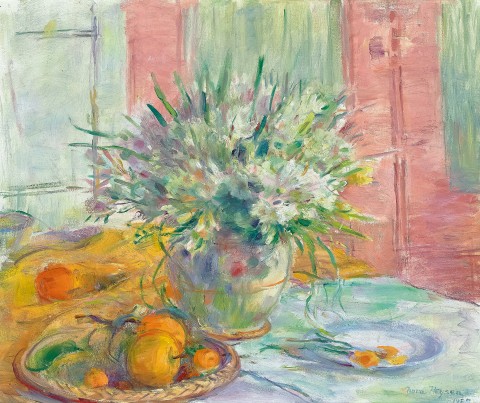FREESIAS, 1985
NORA HEYSEN
oil on canvas
50.0 x 61.0 cm
signed and dated lower right: Nora HEYSEN / 1985
Private collection, Sydney, acquired directly from the artist in 1986
Nora Heysen, National Library of Australia, Canberra, 25 October 2000 – 28 January 2001 (illus. in exhibition catalogue, p. 52)
Nora Heysen: Light and Life, Carrick Hill, Adelaide, 1 April – 28 June 2009; Geelong Art Gallery, Victoria, 11 July – 6 September 2009; S. H. Ervin Gallery, Sydney, 14 November 2009 – 20 December 2009 and New England Regional Art Museum, New South Wales, 15 January – 14 March 2010
Klepac, L., Nora Heysen, The Beagle Press, Sydney, 1989, pp. 73 (illus.), 52
Hylton, J., Nora Heysen: Light and Life, Wakefield Press, South Australia, 2009, pp. 87, 146, 186 - 7 (illus.)
‘Life Class’, The Australian, Sydney, 23 May 2009
Willoughby, A.-L., Nora Heysen: A Portrait, Fremantle Press, Perth, 2019, p. 338
When Nora Heysen held her first solo exhibition in December 1933, the critic for the Adelaide Advertiser was full of praise: ‘One may safely say that never has there been such a wonderful collection of still life studies on the walls of the Society of Arts’ gallery as that displayed by Miss Nora Heysen, daughter of Hans Heysen …’1 Still lifes were a lifelong passion, accompanied by portraits. And, as studio artefacts or objects associated with the person portrayed, still lifes even found their way into some of her portraits and subject pictures. Self Portrait, 1932 (Art Gallery of New South Wales, Sydney) is one fine example. Painted in the studio of her father, Hans Heysen, at ‘The Cedars’, it features the artist’s equipment of boards, bottles, and especially the palette, given to Nora by the internationally-famed Australian singer, Dame Nellie Melba. Another, London Breakfast, 1935 (National Gallery of Australia, Canberra), shows a table set with bread, milk, teapot, cut pumpkin and vase of flowers. Nora’s choice not to paint landscapes was intentional and understandable – ‘to avoid working in the same field as her father’2 – and her many still life paintings in Australia’s public collections are evidence of her extraordinary success in this regard.
The years from 1934 to 1937 which Nora spent studying in London and visiting Italy and France, not only broadened her experiences, but provided a break from the conservatism and tonal realism of her early years. Returning to Australia in 1937, she moved to Sydney the following year, where, apart from war service, she would be based for the remainder of her long life. The move had auspicious beginnings. That same year, at the age of 28, she won the prestigious Archibald portrait prize with Madame Elink Schuurman – the first woman to do so. Another first was her appointment in October 1943 as an Australian woman war artist, serving as a captain in the Australian Women’s Army Service until 1946. Many of her works are now in the Australian War Memorial, Canberra. Her exceptional drawing skills continued to be recognised when she was awarded the Queensland Art Gallery’s L.J. Harvey Memorial Prize for Drawing in 1973 and again, in 1975. Wider recognition came with a series of retrospective exhibitions. First, in 1984 at the Old Clarendon Gallery in South Australia, followed by the S. H. Ervin Gallery, Sydney in 1989, the National Library of Australia, Canberra in 2000, and Carrick Hill, Adelaide in 2009.
Freesias, 1985 is a confident and characteristic later work. Informal in mood and presentation, although still based on the triangular composition, this highly expressive work seems to be almost drawn in paint. Engaging the same directness of her early still lifes, she adopts a higher viewpoint which, combined with the enveloping light and openness of brushwork, enhances the feeling of freedom within the privacy of one’s home. Bolder in style, colours are brighter and the composition more complex. Dominated by yellows and pinks, structure depends on the central darks, verticals and horizontals of the interior setting. Rapid execution, lively lines and gestural touches add to the friendly, conversational nature of the painting.
1. ‘Fine Still Life Studies. Nora Heysen Exhibition Open Today’, The Advertiser, Adelaide, 6 December 1933, p. 12
2. Thiele, C., Heysen of Hahndorf, David Heysen Productions, revised edition, Adelaide, 2001, p. 245
DAVID THOMAS
